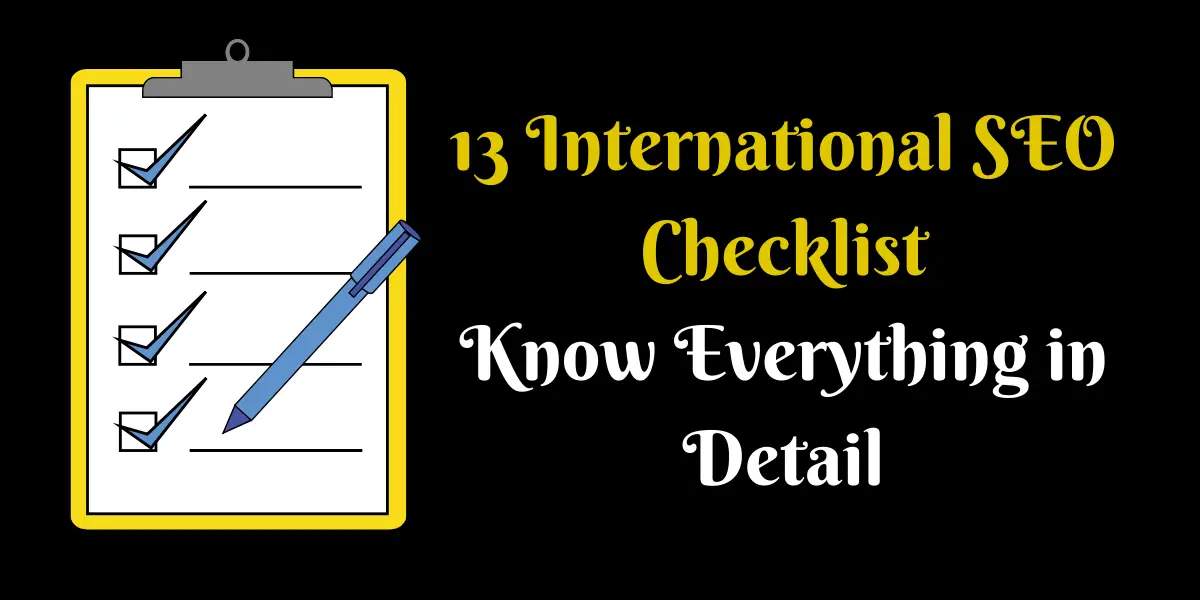13 International SEO Checklist: Know Everything in Detail

SEO can be very helpful for your business if you have experience and expertise to use the technique. Considering international SEO can help you grow globally and reach the international audience. Furthermore, expanding your business internationally and optimizing your website can boost your conversions and drive-in traffic.
Running a website in another language or for the international market is possible, where you can gain lots of audience from that particular country. But with the International SEO checklist, you can easily run your website in your local language and target multiple countries, get high ranking overseas.
International SEO - It is the process of re-creating your website and promoting it in a global environment to increase visibility on different versions of search engines.
There are certain points you need to keep in mind for expanding your business globally which is affordable and also helps you reach the desired foreign market. Here are some of the important checklists for successful international SEO that you can go for.
International SEO Checklist
1. Determine Your International SEO Potential
Doing the research and identifying the potentials to plan for a targeted country. Some researches like checking the countries and languages providing organic search visibility and traffic, looking for the keywords, conversion rate and volume of organic search and more can be very helpful.
- The tools like Google Analytics can help analyze your website for targeting the audience from different countries.
- Google Webmaster tool can get you the search queries report from other locations and also helps to track the international visitors.
- Keyword Planner like Google keyword planner, Bing keyword research tool, and others can be used for relevant keyword ideas for targeting the global market.
- Competitor analysis tools (Rank Checker, Keyword analysis, Google suggest and more) help you to verify the rank of your competitor’s website, analyze the keyword and target audience queries based on the popularity.
Identify the demographics of website visitors
Demographic data is extremely valuable and can shape paid advertising channels, your website, and even the business model. You must identify potential customers through criteria like age, gender, religion, family size, race, job, education, and even marital status.
One of the top ways to identify demographics is to find from which countries, visitors are coming to your website. This is where International SEO comes into play. If you find website visitors are coming from a different country from which you are located, then make changes to your website to attract international visitors.
International SEO is geotargeting, where you optimize your website for different languages and countries.
- Focus on country targeting with an International friendly URL structure.
- Use language tags to establish the language your pages are targeting.
- You must create and maintain content in target user language.
Identifying from which country you get visitors is crucial because you can target a specific language or country. If you own an online clothing company that manufactures shirts with French slogans, you will target the French language other than a specific country. (Do note that lots of people across the World speak French).
SEMrush to identify International Audience:
In International SEO, hreflangs tell Google which pages must be shown to visitors. This depends on language and location. The wrong implementation of hreflang tags will harm user experience on the website. This means French users will see pages in English or US users will be directed to offices in Canada. The SEMrush Site Audit is exclusively dedicated to address the hreflang implementation issue.
There could be issues with hreflang values like is BE related to the country of Belarus or the language spoken in Belgium. When it comes to JA and JP, which one shows Japan as a country and the Japanese language. The hreflang values must be constantly doublechecked and this is where the International SEO report proves useful.
The biggest problem is hreflang conflict within the page source code. What if Google ignores hreflang tags and displays your pages in the wrong language? What if pages are displayed with wrong contact information? SEMrush warns you on conflicting hreflang and rel=canonical URLs or self-referring hreflang URLs.
The audit report detects problems with links like typo errors, wrong redirects or relative URLs. Google needs absolute URLs to crawl the full URL path. SEMrush helps conduct a semantic analysis of pages which have hreflang attributes. Any hreflang value which doesn’t match detected language gets displayed. SEMrush helps with:
- Collecting best keywords
- Setting up specific location tracking
- Ideas for pages improvement
2. Research and Identify gTLDs
This is a very important aspect of an international SEO checklist to target your global audience in a country or a different language. The most important part of international SEO checklist is to modify the structure of your website to gain more visibility in an international environment. You can target a particular country and language for crawling, indexing and ranking your site.
ccTLD’s or Country-code top-level domain is a domain name used for targeting a particular country by changing the structure of your website URL. For example .co.uk for the United Kingdom, .fr for France and so on.
It is similar to gTLDs (Generic Top-level domain) that can be used for your website structure to increase its popularity. ccTLD is the strongest signal for geo-targeting and helps the users to find relevant results.
In the Sub-directory of your website structure, a separate directory is added to the root domain directory. It is used for country and language targeting as the file resides on a single server. Sub-domain is another way of targeting and is expensive as it requires a separate server for each country domain. It can be used for targeting any country or language.
Let's say your domain is domain.com. You will add a folder called domain.com/France/ to target French users. This is called the subdirectory which follows the generic top-level domain. Subdirectory implementation is easy and inexpensive. But, it's tough to gauge location targeting from just the URL. This is where subdomains have a vital role. A Mexico targeted subdomain maybe mx.domain.com while a UK targeted subdomain might be uk.domain.com.
You could have an Australian site with domain.au and a Canadian site with domain.ca; replacing the .com gTLD. This is an expensive option as you need a domain for each focus country.
Both subdomains and subdirectories don’t separate country-specific websites. This is why you need meta tags. Meta tags are HTML lines on a web page that give google a proper context when crawling the page.
Meta tags resemble both the country and language abbreviation in the subdirectory or subdomain. If the Australian subdomain is au.domain.com, you can add meta tags to each blog post belonging to the subdomain which will be <html lang = es-AU> which designates your webpage as meant for Spanish speakers in Australia.
3. Making your site content and structure localized
Making your site content and structure localized gets comfortable for crawling and indexing by the search engines. Identifying the relevant keywords and phrases helps you to target the language or country in each international web versions. For an effective type of literal translation, each of the page structure should be optimized to target the users from different countries and languages.
The elements that need to be optimized are:
- URL
- Title and Meta description
- Menu and navigation elements
- Headings
- Images and ALT descriptions
- Currency, address, phone, time and weather
- Reviews about your product or services
4. Searchable and easy to navigate
Making your website structure more searchable and navigable lets you detect the country or language of a particular visitor. The state can be located through the IP address of your visitor and identify the language via browser settings. You can also redirect your visitors to the most compatible international version based on their IP and browser language settings, using a 302 redirect.
Use the right language code and annotation that can be utilized by other search engines by:
- HTML Lang
- Content language Meta tags
- HTTP readers
Use the rel= “alternate” hreflang=”x” annotations to specify the language and country you are targeting in your HTML header or sitemap.
Use the Meta content-language to target the language or country of your content by adding content-language in the HTML header.
Giving HTML links in every page header can also be productive for easy navigation.
5. hreflang tags
The hreflang tags are great for sites that have similar content in many languages. You (owner of the site with many languages) prefer to send content to people in their language. Let's say one of your users is Spanish and your page ranks in English, but there’s a Spanish version, you prefer Google showing the Spanish Page in search results for the relevant Spanish user. This is where hreflang tags have a role to play.
These tags are a way to mark up similar pages but aimed at different languages or regions. These are the easy ways to implement hreflang:
- Content that could be in different languages like fr and en.
- Content that has regional variations like fr-us.
- Different combinations of regional variations and languages. The hreflang tags help differentiate between France and the UK or Germany and the US.
The hreflang tag is code where you specify the various URLs on your site. These URLs have the same content but in a different language or targeted at different regions.
If you have a page version optimized for user language and location, users must be sent to that page. The right location and language improve user experience, leading to less bounce rate and higher rankings.
Let's say you have English content targeting the UK, US, and Australia. The difference in pages is really small and google cannot understand what you are trying to achieve and sees this as duplicate content, The hreflang shows the search engine very clearly, it’s the same content but optimized for a different audience.
6. Use Content Language Tags
The content-language entity-header describes the language which is intended for the audience. This helps your users differentiate based on the preferred language. By tagging content with language, you can indulge in language-specific processing. This helps select information from the pages which are in a particular language.
The lang attribute, a popular global attribute, applies to any HTML element. You can specify element language and all child elements using the language subtag. This is a 2 or 3 character code which is defined by a body of international standards. The web page language can be declared by the HTML lang attribute. This is a great assistance to browsers and search engines.
HTML meta element: This attribute specifies the language of a page. Add a meta element to the head section of the page.
HTTP response header: This is used to indicate the language of a page for non-HTML documents like PDF.
<html> tag language attribute: This is used to declare the default language of the actual text on the page.
7. Keyword Research
The keyword research is done in English, or you can use your native language that can be translated and localized. Keyword research should be based on your product that can be easily promoted by your international community. You can do competitor's research for keywords and contents to increase the popularity as well as trust among the international users.
You can use various tools available to identify the most shared content from your competitors. But some are:
- Social crawly tics help you to find your competitor's most shared or promoted content and also monitor the social sharing metrics.
- Followerwonk helps you to explore and grow your social graph, find and connect with new influencers and lets you share your reports.
International Keyword Research
International keyword research is incorporating the three dimensions in the research phase which are language, search engine, and culture. This gives a 3D approach to international keyword research. What is the culture in International keyword research? Culture incorporates the social structure of the environment where you live. Let's have an example to get clarity on the topic. If you enter the term ‘table’ in google search, the bulk of search volume shows the style and shape of the table. However, the results in search engine Baidu show action like what you want to do with the table.
The language dimension shows how people search or phrase queries. This is language structure, users may misspell words, drop accents or split compound nouns. You must check volumes for both versions of a word in International keyword research. This is basically because you could be targeting terms with completely different meanings. Don’t misspell words on the website to attract more traffic. This could be a successful approach when it comes to paid search campaigns on languages and search engines.
Search Engine: This shows where people search. Search engines behave differently across languages and have a unique keyword tool. The popular ones are google keyword planner, Baidu keyword planner, and Naver keyword tool. You can find accurate keywords for your campaigns. Take the help of a native linguist to get the most out of the search engine, for the International campaign.
8. Choosing a CMS Provider
You can choose from the list of open-source CMS provider, and tailor-made CMS target the users in different countries or locations.
Open-source CMS like Wordpress, Joomla, and Drupal are very responsive, and its plug-ins are available for multiple languages and regions. You can easily change the website structure, localization, hreflang, etc., of a site on CMS websites to target the countries or languages.
Tailor-made Content Management System supports non-ASCII websites in different languages like Chinese, Korean, Arabic, and more with specific payment options. It features discussion boards, more for registered users and supports complex site structures with the combination of TLDs and subfolders.
9. Geotargeting
Targeting a site on the international market, you would set the country name as a geographic target in webmaster tools for search engines like Google, Yandex, and Bing. It mainly informs the search engines that you want this site’s visibility on SERPs (search engine results pages) for that particular country. Besides targeting the country, specifying the language, you also should geolocate each one of your international Web versions.
Some of the ways to geolocate are:
- Modifying the website structure by hreflang annotations that mainly indicate the language and country to target. It uses the ISO 3166-1 Alpha 2 codes for different countries.
- Webmaster tools can be used for geolocation by using the geotargeting option of the main search engine and specifying a target country.
- Using a local IP address can be used to geotarget as the search engines take more geolocation signals like ccTLD usage and Webmaster tools. Only change your hosting to get a particular country IP address and quickly optimize the international web versions.
- NAP (Name, Address, and Phone)
Give your NAP information across the network and all business listings that make it easy to find your website anywhere.
Geo-targeting Local Customers
This is a method of determining the geolocation of website visitors and offering content based on location, This is based on country, state, region, city or metro code. It is the practice of delivering content to consumers based on geographic locations. Geo-targeting is used to target local customers.
With google search, you can target a keyword for a set of locations in an area where you want to attract customers. Businesses use this tactic depending on footfalls or home deliveries common in restaurants and e-commerce sites. Geo-targeting is crucial as showing websites to the relevant area of your business for more impressions and clicks. If your restaurant is in Los Vegas the search must show searchers in and around Los Vegas and not San Francisco. This ensures that you target the right consumers using keywords and locations. Geo-targeting helps exclude the areas you don’t serve. Make use of google trends to decide on areas of potential conversion. Volumes are broken down based on country, region or city. If you are selling boats, target the coastal regions like New york.
Advertising Geo-Targeting location
For ads make use of location extensions so that local prospects can reach you. Enable local extensions for search ads so that prospects in specific targeted areas can see your ads. The call extension offers a direct link to your phone line. Call extensions help cut out leakages in landing pages to prevent false leads. Only specify the Adwords you want in the Ads so that you get searchers in your location. This prevents wasted clicks and consequently loss of money.
10. Build International Backlinks
Link building gets difficult as you go international. You need backlinks across countries and languages. Use the same techniques just like local SEO, but on a larger scale.
Identify and leverage International Backlinks:
You will have to run your backlink report with monitor backlinks used to identify external links, pointed towards territory-specific content on the website.
11. Do competitor research
Do look at competitor backlinks to get an idea where they are coming from. Use the competitor links section in monitor backlinks to track all your main competitors and find what they do to earn backlinks. Where they get backlinks, which countries or territories and so on. Ubersuggest is one of the tool to do competitor research from seo audit, keywords, top pages, and backlinks for each page.
12. Find links with local content
If you want great content worthy to be shared in other countries or by influencers, don’t rely on just an English translation. Use native writers if you can.
13. Find social networks in a given market:
Find social media networks which people use in certain countries to generate great traffic and even backlinks. The Chinese audience may prefer Sina Weibo while a US audience prefers Facebook. You must embrace local communities. Be there at local events and watch your International reputation grow at trade shows. Local events give access to guest blogs or profile pages.
Conclusion
International SEO Checklist can help you to be more successful in your business while trading your products or services online in a global market. It’s a full SEO process that can be implemented and targeted by the international audience by doing proper research and analysis for selecting the best process. However, there are more process or ways for making your website a global success; but above said are some of the tops and will deliver results quickly. Each one of your international Web versions will need continuous content, technical, and marketing support for growing its popularity in a global market.





